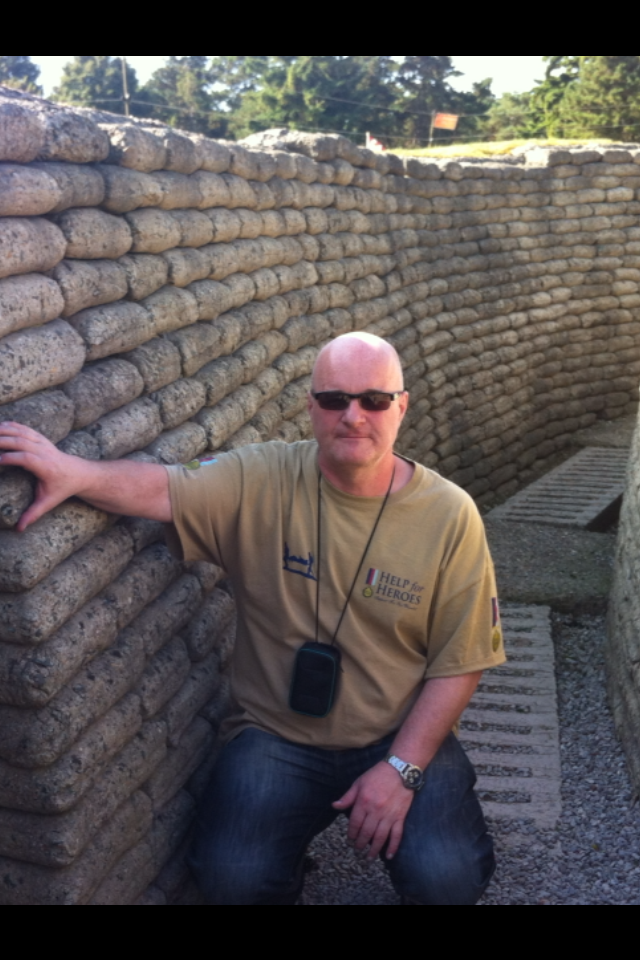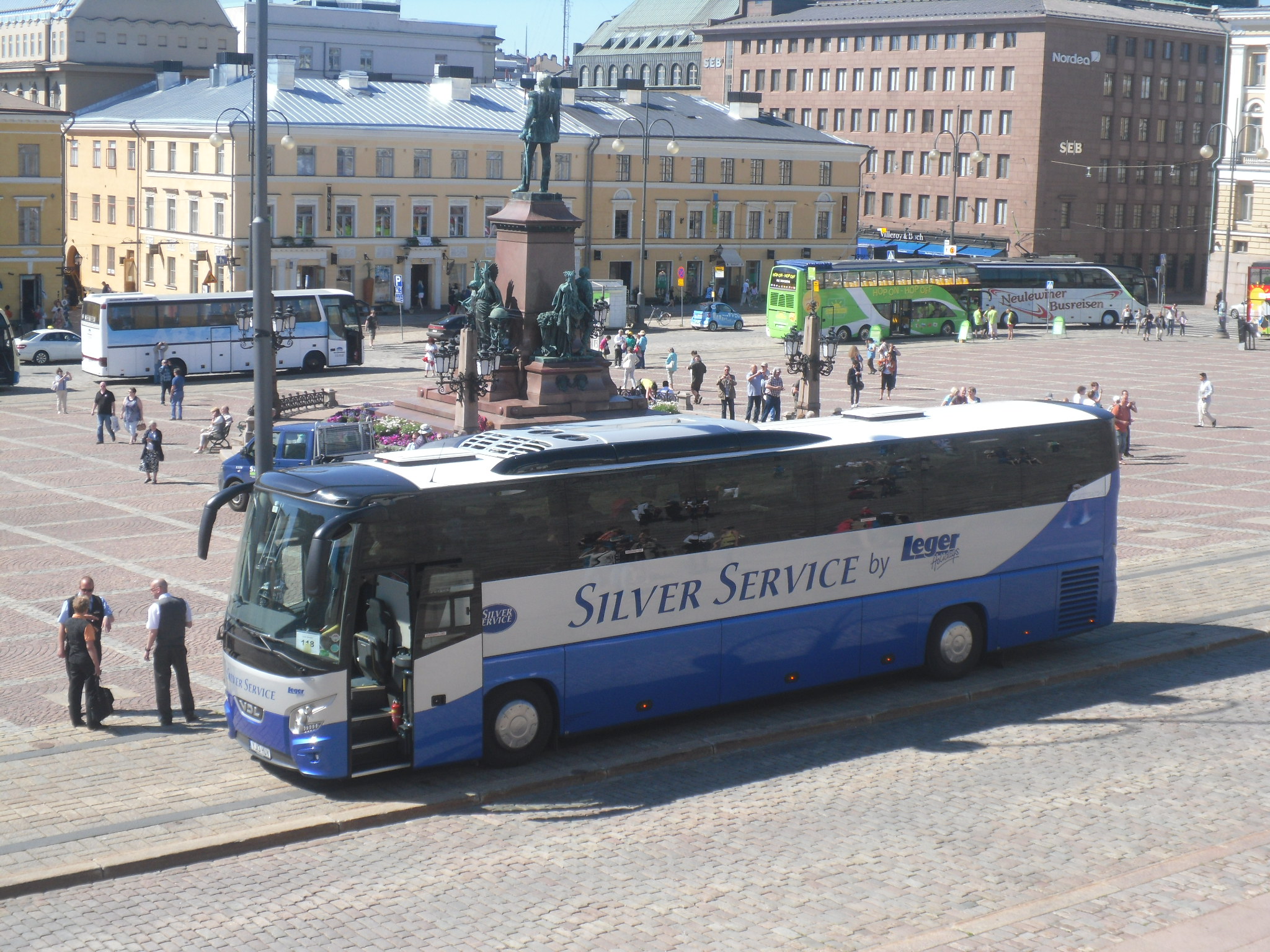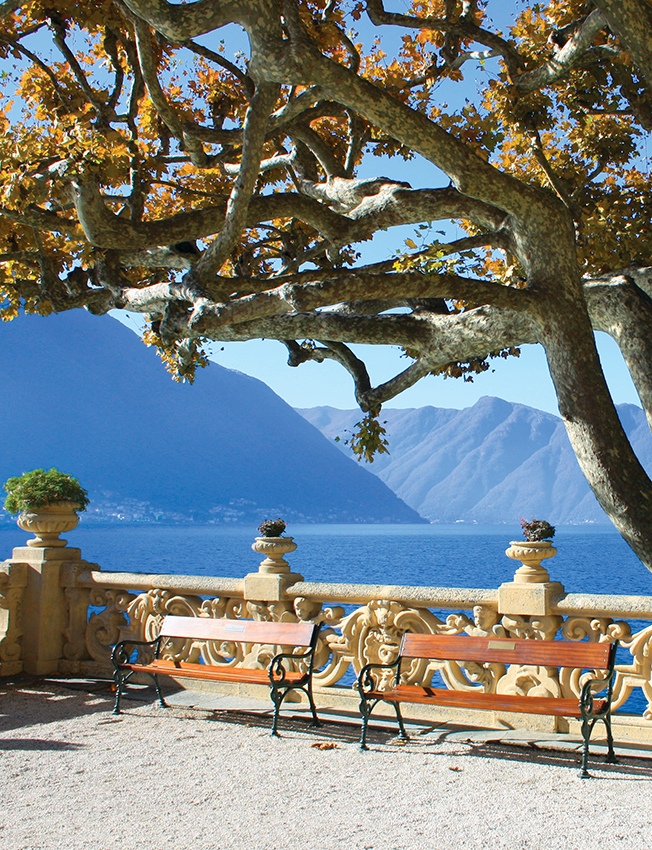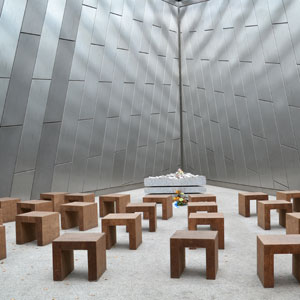Paul Prendergast had a couple of very special reasons for joining Leger’s 5-day All Quiet on the Western Front tour.
My interest in WW1 goes back a few years and was kicked off again by some research that I started at work.
I work for Royal Mail in Stockwell London SW9 where I am a Delivery Office Manager. Every office has a plaque dedicated to the dead of both wars. The plaque above my office has 6 names on it (I’ll come back to this later).
On the morning of our tour, we were met at Peace Pottage by our feeder coach and then travelled to Dover where we all boarded the ferry to head to Calais. On arrival in France we changed to our tour coach where we met Andy and Barbara who were our drivers/hosts on the Silver Service coach. We also met Iain McHenry, our Specialist Battlefield Guide who spoke about our tour.
Day 2
We set off at 09.00am to Tyne Cot Cemetery, where the graves of 12,000 men are buried and remembered. It makes you realise how senseless war is when you see that. I’m a member of the Victoria Cross Trust, and I also got to see the graves of three Victoria Cross holders.
We also visited then Sanctuary Wood and some trenches that have been preserved by the owner, and on arrival we heard a guy playing the bagpipes.
We then went onto Hooge Crater and Cemetery. The place was kept in beautiful condition by the CWGC, and I also found another VC grave.
After lunch we headed towards the Messines Ridge and we stopped at the Ulster Peace Tower, where our guide pointed out the German Front lines and spoke about the famous Christmas Day truce. He also pointed out that past the tower, a house/farm still has 50,000 tonnes of explosive under it!
We then stopped at another cemetery where there was a Jewish grave. I placed a stone on top the headstone – this is Jewish custom and there was no stone on there. This was the least I could do.
The final and most moving part of the day was the Menin Gate Last Post Ceremony. On the Menin Gate are the names of 55,000 men killed or missing. I was nearly in tears when I saw this monument to the people who gave their lives for our freedom. On the wall I found the names of the people from The Post Office Rifles… this is where the story about my reason for going unfolds. I placed a small cross of remembrance there for the six men killed from my workplace.
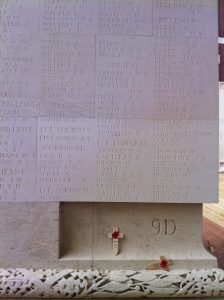
Day 3
This was going to be a day of very mixed emotions for me. When we were on the way to Wellington Quarry it gave you a real idea of the people who lived, slept, ate and dug themselves into no man’s land.
We then went to Arras. There is a wall with the names of 36,000 men missing or killed in action there, and this is when it became very personal for me. The reason for this is that there was a name on the wall: rifleman John Williams 371151, died 16/06/17 2/, Post Office Rifles LONDON 2/8 BTN. Postman, Stockwell Delivery Office… The place where I now work.
I placed a cross of remembrance on the wall.
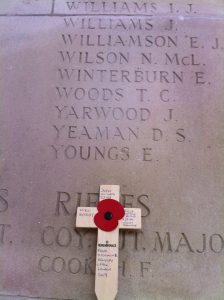
While sitting there, trying to imagine what he went through, a thought crossed my mind. All I could think was how honoured I am that I could say to him: “We have not forgottenâ€. I felt a mixture of pride – that I now work where he worked; honour – placing a cross by his name; and sorrow – knowing that his family could not bury him.
It was a very thought-provoking day for me.
Day 4
We had a long drive to La Boisselle, which is the biggest man-made crater on the Western Front. It was made by placing tonnes of explosive under the German front lines, then exploding them all at once. You cannot imagine what the scene of carnage must have been when this happened.
Our last visit of the day was to the Thiepval Memorial. It is the biggest memorial, with the names of 77,000 men missing or killed. I was looking for one: Sgt George Ryder 2512, died 07/10/13, Post Office Rifles LONDON 1/8 BT. He is the second of the two men that I traced, and the reason for my trip to the Western Front. Sgt George Ryder died 97 years ago on the week of my visit, so to finish the tour in this way, and by placing a cross by his name on the panel, again I can only feel proud. I just wish that, in some way or another, these people who fought for us could see that we still care about what they did for us 100 years ago.
The All Quiet on the Western Front five-day tour is the best way to see all the sites, and the guide, Iain McHenry was first-class. He helped me to find the names of the people that I came to remember on the walls, and also pointed out the VC winners to me. His knowledge of the subject was tremendous. The coach staff, Andy and Barbara were polite and very friendly throughout.
I will be going back – not just yet, but I still have four more names to find.
Susie's Amazing Grand Explorer Adventure
Susie’s Amazing Grand Explorer Adventure
Sue Clark one of our customers has not long returned from her holiday with Leger Holidays. Read on to see what she thought of her trip with us on our Arctic Circle and the Land of the Midnight Sun Tour.
Which tour did you go on?
I went on the Arctic Circle and the Land of the Midnight Sun 16-day Grand Explorer trip departing June 29th 2013
How did you get there and how long did it take?
Initially by feeder coach in Lincoln, which also was our tour coach, and I undertook the whole tour by coach. During the adventure I also travelled on 10 ferries, which included an overnight one from Stockholm, Sweden to Turku in Finland
As mentioned previously, it was for 16 days, but as someone who travels as she lives, preferring the journey to the destination-it was paced just right.
Where did you stay?
Too numerous to mention and in a variety of accommodation, including a ski chalet.
What was the weather like? Did it affect your visit?
This tour was not about the weather but the experience, but the added bonus was that for the majority of the time it was glorious weather. I witnessed the Midnight Sun in Rovaniemi in full sunshine. The visit to North Cape was cloudy and windy, but very atmospheric. It rained in Tromso but that only added to the beauty of the countryside. Without the rain I would not have experienced the wonderful waterfalls and lush scenery we travelled through.
Which optional excursions did you do?
I booked the guided sightseeing evening tour in Oslo, and what an enlightening tour this was! I was completely unprepared for the visit to the Vigeland Sculpture Park, and as a sculpture spotter I was in raptures. For me, this optional excursion was worth every pound I spent on it!
Conclusion
In the words of one of our drivers, this was an adventure rather than a holiday, and it was an adventure I would not have missed! Throughout the adventure I grew in cultural, spiritual and geographical experience. It was also a very positive experience because I travelled with a lovely group of people and also a couple of great drivers.
This experience has convinced me not only to undertake more Leger Grand Explorer tours, but also to visit Scandinavia, particularly all the capital cities, for longer as I was only able to have ‘tasters’ on this occasion.
Thank you Leger, without whom I would not have been able to have such an amazing Grand Explorer adventure 🙂
My first time travelling alone
“Just go for it” I told myself. “What’s the worst that can happen?”.
I was thinking about going on holiday on my own for the first time. I’d always had someone else to share the decision making, the evening meals, even the journey with, so it would be quite unusual – even a bit scary – to be ‘going it alone’. But I wanted to get away. So I stopped thinking of all the reasons for not going. And I booked.
First Steps
Working for Leger, I knew that Single Traveller holidays were part of the programme, and so I decided to opt for one of them – The Beauty of Lake Como and Lake Maggiore – as my first experience of ‘single travel’. Quite literally, a ‘busman’s holiday’!
I wasn’t really sure what to expect, but knowing that I would be on a coach with other people – despite them being strangers – made going on holiday on my own seem slightly less daunting. Having said that, I was still a bit nervous on the morning of my holiday. I was getting a taxi – a woman, on my own – to my pick-up point where I would join my feeder coach. The thought of travelling in a taxi on my own always makes me a bit nervous, but the Door-to-Door service that you get on Single Traveller holidays meant that Leger had sent the car to get me, so I didn’t feel too worried.
Getting to Know You
On the first day of the holiday the people on my tour coach were a bit subdued, but when we’d had our first night’s sleep and everyone was refreshed and ready for the first full day as a group, things started to change.
The following day, as we made our way through France and on towards Italy people started chatting to the person next to them, making conversation at comfort breaks and spending time at the back of the coach in the rear lounge (we were travelling on Silver Service), where everyone seemed to be getting on great. Our drivers did an excellent job of making sure we were all OK and keeping everyone supplied with drinks, and by the end of the week, it might sound like a bit of a cliché, but we really were like one big happy family.
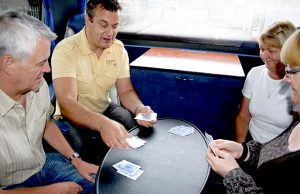
Strangers Become Friends
On our days out I enjoyed a walk along the edge of the lake in Lugano with one member of our group; a ride on the Bernina Express Railway through some fantastic scenery with some of our ‘gang’ – some said this was the highlight of the trip; a walk around the little town of Tirana with one lady; and a stroll around the lovely town of Stresa, finding my way around the little streets there with some of the others. We had some really great times. Great memories.
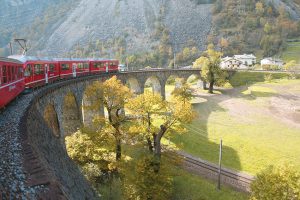
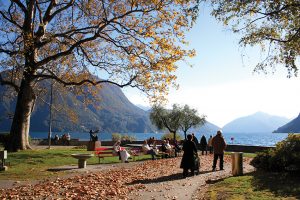
Our hotel – the Britannia Excelsior in Cadenabbia – was in an excellent location, right on the shores of Lake Como. Some evenings when we came back from our days out I enjoyed a bit of time to myself, having a drink at one of the little bars close to the hotel, just happy to sit on my own, looking out at the views over the lake. It was so peaceful.
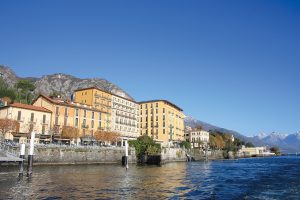
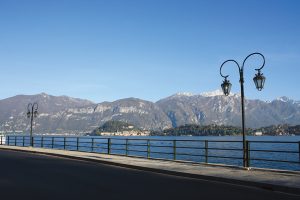
As the holiday went on, we all got to know each other, chatting about where we’d been before, whether we’d been on holiday on our own before, what we thought of the holiday etc… We ate together on long tables every night and then moved to the large bar area after dinner where we chatted about the day and what we’d seen and done. When there wasn’t enough space in the bar for us all to be together, we improvised and made our own ‘bar area’ in the hotel’s lounge. We played games (invented by one individual in our group), danced to the live music, sang and laughed until the early hours each day.
No Regrets
Looking back, it’s hard to remember why I’d had any worries about travelling alone in the first place. I never once felt alone, even though everyone was travelling alone. Because of that, I think people made a bit more of an effort to talk to each other and get involved. There were, of course, those people who just wanted to keep themselves to themselves and spend time on their own and that was fine too. There was no pressure to do anything.
No Need to Worry
So, if you’re alone – for whatever reason – and still want to go on holiday, don’t be afraid of travelling alone. If I’d thought about it too much, I could quite easily have talked myself out of it, but now I know I had absolutely nothing to worry about.
If you go on a Single Traveller holiday, it’s your holiday and it can be whatever you want it to be. From my experience, if you want to have time on your own, it’s still comforting to know that the rest of the group is there if you want to join in with them. And if you like to mix and get to know people, there are plenty of people there who also want to get together and make new friends. One thing I would say, is to choose a holiday and a company that’s right for you. See what they offer single travellers. For me, the fact that I got a taxi sent to pick me up and I didn’t have to get one myself was reassuring, along with the fact that I would get my own room without having to pay a single supplement. Just see what’s right for you.

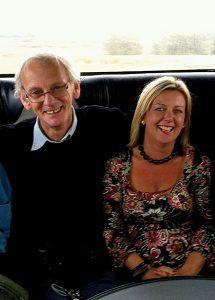
Just the Beginning
Since I joined my first Single Traveller holiday a few years ago, I’ve travelled many times on my own, been to some fantastic places and met so many wonderful people along the way, all of which I might not have experienced if I’d not taken that first step. I’d still not attempt backpacking around the world on my own – that would be a step too far for me – but I have no problem whatsoever in joining a group of people, both single and mixed groups of travellers, who all have the same thing in mind: to see more of the world.
So, if you’re deliberating about going on holiday alone, stop thinking and just go for it.
Share your single traveller holiday stories with us!
To find out more about Leger’s Single Traveller holidays, click here.
The Story Of Anne Frank and Oscar Schindler by Linda Barrington-Smith
Having wanted to go on Leger’s Story of Anne Frank and Oscar Schindler battlefields tour for quite some time, Linda and David Barrington-Smith found it was certainly an experience to remember.
Linda is a Freelance Journalist and David is a professional photographer. They have both travelled with Leger Holidays before and this time they have kindly written an article about their experiences whilst on our tour – The Story of Anne Frank and Oscar Schindler.
On January 20, 1942 in the dining room of a beautiful lakeside villa in the Berlin suburb of Wannsee, 15 high-ranking representatives of the SS, the NSDAP and various ministries met for a conference, chaired by Reinhard Heydrich, to discuss and co-ordinate the implementation of what they called “the final solution of the Jewish questionâ€. The ‘Final Solution’ being the code name for the systematic, deliberate, physical annihilation of 11 million Jews in Europe.
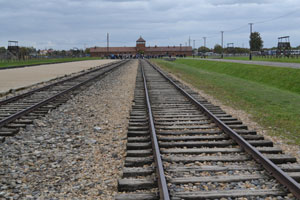
While the enormity of the European Holocaust can be very emotive and hard to take in, Leger’s The Story of Anne Frank and Oscar Schindler battlefield tour helps bring into perspective the events of that terrible period in European history.
The tour is one that we had wanted to take for quite some time. So when the opportunity finally arose, we didn’t hesitate!
The local pick-up arrangements for the trip down to Dover, where we met up with our excellent tour coach drivers Dave and Gary and specialist historical guide Richard Bass, went smoothly, as did the journey to the first overnight stop.
Day two saw the tour start to follow the story of the Frank family with a visit to the Anne Frank House and museum in Amsterdam.
For just over two years Anne Frank and her family hid in the Secret Annexe of the canalside house at Prinsengracht 263 where Anne’s father, Otto Frank had his business.
A bookcase marks the entrance to the annexe, reached via several flights of steep stairs, which they shared with four other Jews.
Although today the rooms are sober and unfurnished, they still breathe the atmosphere of that period of time.
Anne, who was 13 when the family went into hiding, wrote her now famous diary in the annexe. Quotations from this, as well as historical documents, photographs, film images and artefacts illustrate the events that took place here.
On August 4, 1944 the occupants were betrayed and deported to various concentration camps. Only Otto Frank survived the war.
After our visit, the tour continued to Hannover for an overnight stay.
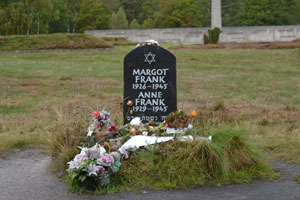
The next day we paid our respects at Bergen-Belsen where Anne Frank and her sister Margot died of typhus in March 1945, only a few weeks before liberation.
Today, Bergen-Belsen is a place of remembrance — a tranquil cemetery with mounds of mass graves containing more than 70,000 people and various memorials — including one dedicated to Anne and Margot Frank.
We have visited the site before, but at that time the new Documentation Centre hadn‘t been opened. A forbidding concrete building, designed to make one aware that Bergen-Belsen was not a pleasant place, we spent quite a while looking at the excellent exhibition. Packed with information, videos, photographs and personal belongings excavated after liberation, it graphically tells the story of the people that worked, died or somehow survived at the camp.
Next stop was Berlin.
The first day in the German capital was spent studying the ‘Final Solution’, starting with a visit to Sachsenhausen Memorial and Museum.
Established as a concentration camp in 1936, up until 1945 more than 200,000 people from all over Europe were imprisoned here; tens of thousands died from hunger, sickness, forced labour and abuse, or were victims of systematic extermination.
Liberated by Soviet troops in April 1945, the freedom was short-lived as the Soviet secret police turned it into a prison camp and the misery and death continued for another five years.
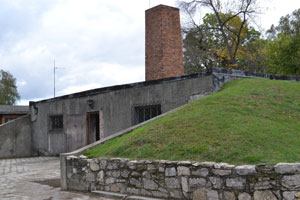
Several buildings and structures survive or have been reconstructed, including the camp entrance, guard towers, cell block, small gas chamber and crematory ovens.
After this sobering visit, a walk was taken across the Glienicke Bridge, where East and West swapped spies during the Cold War, before going on to the House of the Wannsee Conference.
Our second day in Berlin was packed. Starting off at the Berlin 1939-1945 War Cemetery, we then visited the Olympic Stadium before continuing to the Plötzensee Memorial Centre, in the old prison yard behind the modern day prison, where among nearly 3000 people executed here were some of the July 1944 plotters. The execution chamber still houses the original gallows.
After this chiller we saw the German Resistance Memorial Centre, located in the historic section of the former headquarters of the Army High Command at the Bendlerblock. It was here that Colonel Claus Schenk Graf von Stauffenberg and other members of the failed attempt to assassinate Hitler on July 20, 1944 were shot by firing squad.
Then it was on to the Topography of Terror Documentation Centre with exhibitions illustrating the European dimensions of the Nazi reign of terror.
After seeing the site of Hitler’s Bunker, we finished up at the Memorial to the Murdered Jews of Europe. Designed by New York architect Peter Eisenmann as a Field of Stelae containing 2711 stark concrete blocks, it is only by walking among them that the powerful atmosphere of this memorial can be felt.
Next day the tour travelled on to Krakow in Poland.
The first day in this beautiful city we strolled through the old narrow streets of Krakow’s Kazimierz district, which still retains a unique atmosphere of its Jewish past. After the ravages of the Second World War the area became run down. But in recent years it has become a thriving district once again, thanks in part to Steven Spielberg’s Oscar-winning film Schindler’s List.
Next stop was Podgórze, site of the former Jewish Ghetto between 1941 until 1943 and from where the Jews were deported to the nearby Plaszów Concentration Camp and other death camps. Today, the main square has been turned into an evocative memorial to the victims of the Krakow Ghetto, laid out with 70 large bronze chairs symbolising departure as well as subsequent absence.
Close to the ghetto lies Oscar Schindler’s Factory of Enamelled Vessels Emalia, used by Schindler in his remarkable attempt to save the lives of his workforce. It has been turned into a modern museum with ingenious exhibitions combining period artefacts, photographs and documents with multimedia and set-piece arrangements to create a full-immersion experience of life in Krakow from pre-war until after liberation.
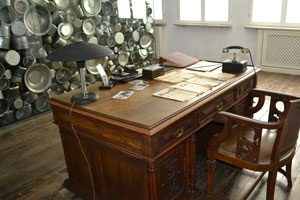
Oscar Schindler, his factory, and the fate of its Jewish workforce feature prominently. The main part of the exhibition dealing with Schindler himself is his office which retains original elements of the interior in the shape of architectural detail and a 1940s map of Europe with city names in German.
Opposite a desk from the period, with an arrangement of Schindler’s family photos, is a stunning glass cube filled with metalware. The walls of the metal cylinders inside the cube bear the names of around 1100 Jews saved by Schindler.
Afterwards the tour headed for Plaszów Concentration Camp, a windswept park where all traces of Nazi atrocity have been erased. But we did manage to see the house that the camp’s notorious commandant Amon Góth lived in and the Plaszów Memorial, dedicated to the victims of the camp.
Next day was spent at the Auschwitz-Birkenau complex — a symbol of terror, genocide and the Holocaust around the world. The total number of victims at Auschwitz between 1940-1945 is estimated at between 1.1 and 1.5 million people, around 900,000 thought to be Jews.
The Auschwitz-Birkenau State Museum includes two sections of the camps — the brick buildings of Auschwitz I and the immense concentration and death camp at Auschwitz II (Birkenau) three kilometres away.
Some of the most chilling exhibits at Auschwitz I, set behind protective glass, must surely be the cans of Zyklon B used in the extermination process, tons of human hair, suitcases with names and addresses of deportees, shoes, artificial limbs, spectacles, children’s toys and clothing — which make pretty powerful viewing.
While there is less to see at Birkenau, its size and solitude makes it more deeply moving than Auschwitz I with its thousands of daily visitors.
At Birkenau one can see the watchtower, railway line and selection ramp — images well-known from documentary films and books; remnants of four crematoria, gas chambers and cremation pits, all of which make a profound impression on everyone who visits the camp.
Leaving Poland an overnight stop was made in Prague in the Czech Republic, where we saw the site of Reinhard Heydrich’s assassination. Then it was on to Nuremberg for a look at the Courthouse where the Nuremberg Trials took place, before travelling through the Rhine Valley on our way to Calais and the ferry home.
Although our epic 4570 kilometre journey was emotional at times, there were lighter moments — a free jazz concert in Celle, dancing to a pop concert at the Brandenburg Gate in Berlin and a cruise on the Rhine among them.
It was certainly an experience to remember.
Keep an eye in your local newspapers and magazines for further details about this thought provoking tour from Linda and David Barrington-Smith

